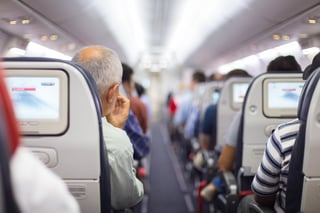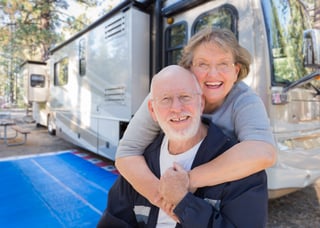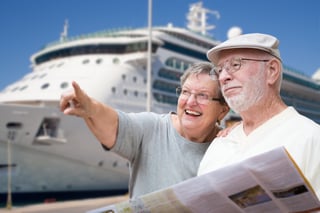Different Methods of Travel
Many of you like to see the country side and plan on spending the spring time traversing America's scenic byways either by driving yourselves in a car, or RV, or taking a tour bus. Some are planning to hit the high seas and head to tropical climes on a luxury liner, basking in the sun by day and winning big at the casino at night. Train travel is making a comeback with riders socializing in dining cars or enjoying the scenery as they rumble by in their private sleeper cars.
All of these transportation means are possible with portable oxygen concentrators there are just a few things you need to know first.
Air Travel
As I said, all of our concentrators are FAA approved and under the ADA all public places, including airports must allow them.
Going Through TSA
TSA agents are becoming increasingly used to seeing concentrators and know what they are so you shouldn't have a problem.
- If you can disconnect from your oxygen, do so and put it through the x-ray machine with your other carry-on items.
- If you must stay on your concentrator 24/7 just let the agent know that you will need a manual check. You will be led to a private area where they will check you with a metal detecting wand and hand check your machine and bag.
- If you need further assistance or have questions, TSA has a hot line that you can call specifically for travelers with special medical needs, 1-855-787-2227.
- Particularly now that we are heading into peak travel season, give yourself plenty of time to get through security.
Getting Cleared for Take-Off
Though the FAA has cleared all of our concentrators, airlines have their own regulations  regarding their use in flight.
regarding their use in flight.
- Generally speaking they will expect you to have at least 1.5 times the battery life of the flight duration. If your flight is 2 hours, they will expect you to have 3 hours worth of battery life.
- Many airlines have a form that must be filled out and signed by your doctor.
- It's a good idea to carry a copy of your prescription as well, in case anything should happen or if airline personnel wish to review it.
- Be sure to call your airline at least two weeks before you travel to find out what their regulations are. You will likely need that much time to gather together all the materials that you need.
- Keep in mind that the FAA only governs flights that originate in the USA. If you will be flying internationally be sure to ask the airline about regulations where you're going. Also, bear in mind that other countries have different electrical outlets than the US so you may need an outlet adapter.
- If you're taking short commuter flights or tours on your vacation, be sure to find out what their requirements are.
Rules of the Road
All of our concentrators come with a DC power supply that plugs right in to the cigarette lighter of your car, RV, or boat.
Some Words of Caution About A Concentrator on a Road Trip
- Plug your concentrator into the outlet that is closest to the battery. The further
 away from the battery, the weaker the current.
away from the battery, the weaker the current. - Plug your concentrator in whenever possible to preserve battery life in case of a breakdown.
- Don't let anyone smoke in the car or anywhere near your concentrator.
- Place your concentrator upright and in a secure place while driving.
- Carry a copy of your prescription with you at all times.
- Extremes in temperature are detrimental to your concentrator so never leave it in a trunk for long periods of time.
- Don't leave the concentrator plugged in when the car is off as it may drain the battery otherwise.
Bus Trips
Ask for directions when booking your ticket. Most companies require at least 48 hour notice that you will be traveling with oxygen. Greyhound's customer service line can be reached at 1-800-752-4841.
All Aboard for Train Travel
When traveling by train, contact your specific carrier for details. The major carrier in the US is Amtrak. They require 24 hour notice that you will be traveling with a concentrator. You can reach their customer service line at 1-800-USA-RAIL.
Sea Cruise
Going on a cruise might be one of the easiest methods of traveling with oxygen. First of all, they always have a doctor on board if you should need one. Carry a copy of your prescription and once on board, go check in with the doctor just so they are aware you are on board and have some basic understanding of your condition.
- Each cruise line has their own regulations for oxygen patients so check at time of
 booking what will be required of you.
booking what will be required of you. - Your state room will have outlets for you to charge your concentrator if necessary.
- Familiarize yourself with outlets in certain areas of the ship in case you need to recharge and don't feel like walking all the way back to your cabin.
- If you are taking daily excursions from the ship be sure to take along plenty of batteries. Account for extra time in case of unexpected delays.
Go Have Fun!
With just a little bit of pre-planning your vacation can be what vacations ought to be, fun, stress free, and relaxing! We have a tech-support department which can be reached at 1-800-520-5726. They can answer any questions you might have about batteries, planning your trip, or any accessories that might be available to make your trip easier.
Download our Free Guide!
It has all the information you need to know and checklists to ensure that you have everything you need to make your trip a success. It also has links and phone numbers for all major airlines so that you can download necessary forms or call for info. CLICK HERE to download!





